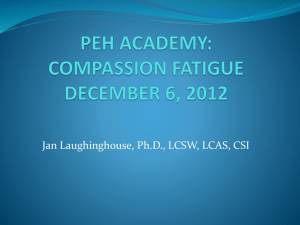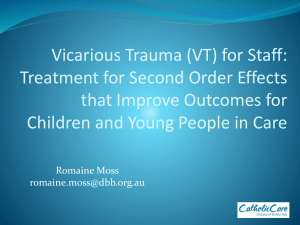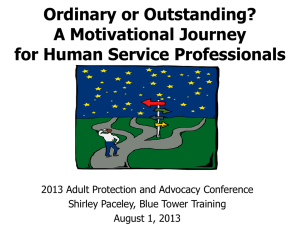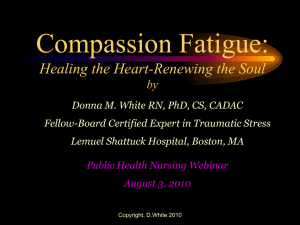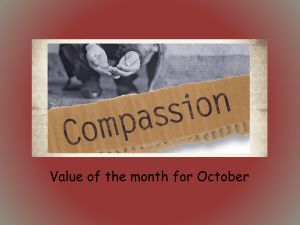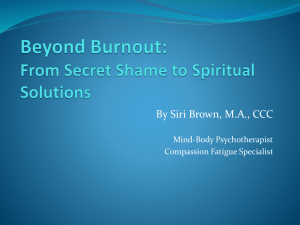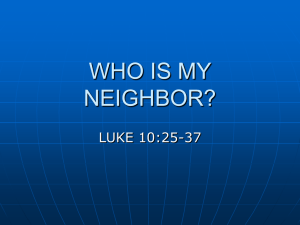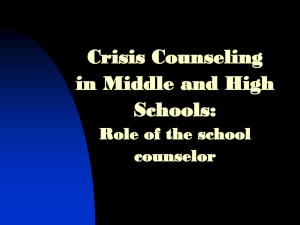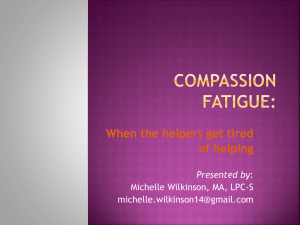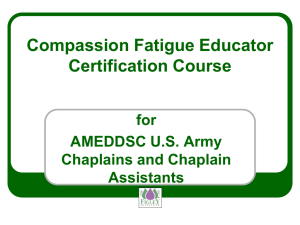So Your Staff Needs a Self-Care Program? (1PowerPoint)
advertisement
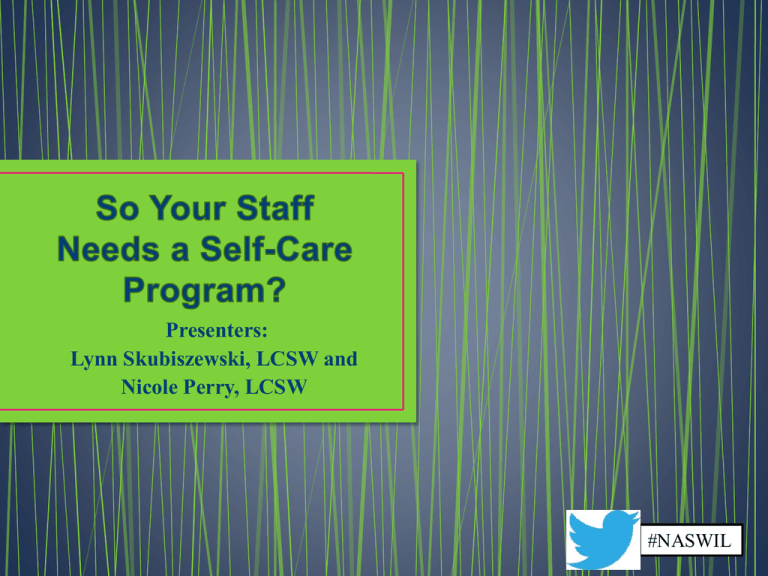
Presenters: Lynn Skubiszewski, LCSW and Nicole Perry, LCSW #NASWIL http://www.youtube.com/watch?v=XSu_sVgGWMk • Lynn Skubiszewski, LCSW Palliative Care Social Worker, JourneyCare lskubiszewski@journeycare.org • Nicole Perry, LCSW Social Worker and Team Manager, JourneyCare nperry@journeycare.org Lynn is a graduate of Aurora University School of Social Work and has worked in the academic, geriatric, and healthcare fields for over 20 years. She has an interest in coaching the helping professionals in self care and encouraging social workers in healthcare settings to embrace leadership roles in their multidisciplinary settings. Nicole has an MSW from the University of Wisconsin – Madison. She has worked as a Social Worker since 2006 in the fields of aging and hospice. Nicole enjoys leading an interdisciplinary staff team to provide excellent end of life care and symptom management to the patients of JourneyCare. #NASWIL • Poor Quality of Life • Poor self-care = burnout/dissatisfaction = drop out of SW field • “In light of recent and significant research indicating that social workers engaged in direct practice are likely to develop symptoms of secondary traumatic stress, it is imperative that the social work profession devotes greater attention to and creates greater awareness of these issues.” (Professional Self-Care and Social Work, policy statement approved by the NASW Delegate Assembly, 2008) • Poor self care = reduced ability to be empathic • Define burnout, compassion fatigue, compassion satisfaction, secondary trauma, vicarious traumatization/post traumatic stress. • Research Project • What is self – care? • How can you start self care? • Resilience, Personal Self Care, and Realistic Expectations • How to Expand Self-Care to the Organization Level • Summary and Review Resources/Tools • “A relatively frequent outcome of chronic stress that has received considerable attention.” • Refers to the gradual extinguishing of energy of a Social Worker. • What leads to burnout? Schaufeli, Leiter, & Maslach, 2009, p 205. Maslach and Leiter, 2005 Cox and Stiner, 2013 Burnout is the opportunity to rediscover what makes you happy. 10 Phases of Burnout "Preventing Burnout" by psychologists Herbert Freudenberger and Gail North : Long-Term Living 59.5 (May 2010): 50-52. Listen to others who know and care about you Use assessment tools to help you see the truth Self awareness – know when you are crossing a line Is it really the client or is it more than that? Is it your organization? Is it unrealistic productivity expectations? • TOP 10 SIGNS OF BURNOUT #10 – Shopping at Kmart feels like you’re taking good care of yourself. #9 – Patients frequently startle you by waking you up during home visits. #8 – Find yourself saying, “You think you’ve got problems, lady?” #7 – You become aware of a reluctance to go to work and don’t go to work. #6 – You accidentally drop your beeper from a high bridge. • #5 – You jump after the beeper. • #4 – Giggling during team meetings. • #3 – Not giggling during team meetings. • #2 – Eating an entire bag of Dorito chips while making bereavement phone calls. • #1 – Who cares about this list anyway? Larson, National Hospice and Palliative Care Organization • Similar to PTSD - Easily frustrated, irritable, annoyed • Symptoms of depression-difficulty maintaining hope • Feeling over alert, restless • Feeling ineffective, negative, inadequate • “CF is the natural, predictable, treatable, and preventable unwanted consequence of working with suffering people” (Figley, 2000, p. 124 of Treating Compassion Fatigue) Compassion Fatigue • Compassion Satisfaction Also called Secondary Traumatic Stress • A set of behaviors and emotions that can occur when the SW is seeking to help a suffering person. • “a feeling of deep sympathy and sorrow for another who is stricken by misfortune, accompanied by a strong desire to alleviate the suffering? Figley, 1995 Teater, 2012 Larson • Defined as the pleasure derived from helping others. • Sounds like: • I have happy thoughts about those I help • I like my work • I enjoy and trust my co-workers • I am effective Craig and Sprang, 2010 Although the world is full of suffering, it is full also of the overcoming of it.- Helen Keller Compassion Fatigue • Also called Secondary Traumatic Stress • A set of behaviors and emotions that can occur when the SW is seeking to help a suffering person. • “a feeling of deep sympathy and sorrow for another who is stricken by misfortune, accompanied by a strong desire to alleviate the suffering? Figley, 1995 Teater, 2012 Larson Compassion Satisfaction • Defined as the pleasure derived from helping others. • Sounds like: • I have happy thoughts about those I help • I like my work • I enjoy and trust my co-workers #NASWIL 50% of child protection staff suffered from high or very high levels of compassion fatigue 70% of staff expressed a high or good potential for compassion satisfaction Conrad and Kellar-Guenther (2006) What Creates Compassion Satisfaction? • Social workers are affected by exposure to their clients' traumatic life experiences and behaviors. Research has demonstrated that secondary traumatic stress (STS) - also referred to as vicarious trauma, compassion stress, or compassion fatigue - is prevalent among mental health professionals who work with traumatized clients (Fahy, 2007; Figley, 2002b;Jacobson, 2006;Jenkins & Baird, 2002; McCann & Pearlman, 1990) • (VT) common when population exhibits: • Suicidal Behavior – Fatal and Non Fatal • Reported feelings of guilt, failure, professional self-doubt regarding their clinical competency, and anger directed toward the client (Chemtob et al., 1988, 1989; Ellis & Dickey, 1998; Grad, Zavasnik, & Groleger, 1997; Kleespies, Penk, & Forsyth, 1993; Ruskin, Sakinosfsky, Bagby, Dickens, & Sousa, 2004;Yousaf, Hawthorne, & Sedgwick, 2002) #NASWIL Highest for those who work with: • Sexual Offenders • Trauma Victims • Natural Disaster Victims • Victims of Terrorist Attacks • Suicidal Clients • Refugee Populations • Violence against Families/Children … findings suggest that the experience of compassion satisfaction and the development of vicarious resilience counterbalanced the intense difficulty of bearing witness to clients' traumatic experiences and the potential for vicarious traumatization. • Secondary Traumatic Stress – “the natural and consequent behaviors and emotions resulting from knowing about a tramatizing event experienced by a significant other – the stress resulting from helping or wanting to help a traumatized or suffering person.” Figley (1993, 1995) • Vicarious Traumatization – “the transformation in cognitive schemas and belief systems as a result of empathic engagement with survivors of traumatic experiences.” McCann and Pearlman, 1990 Pilot Study at Journey Care • 5 Advanced Practice Nurses/Nurse Practitioners in Palliative Program part of Palliative/Hospice Agency Average Years as APN = 6 ½ • Palliative Care and Hospice Experience = 7 months to 10 years • Ages: 45 to 60 years of Age • Question: Do you currently practice Self Care?: 4 out of 5 = Yes • Question: How long have you engaged in Self Care as a Nursing Professional? Average 2.5 years • Coordinator Data • Palliative Care LCSW with 2 years with team – 20 years as social worker experience on Assess if your Staff or Team is in need of Self Care • 5 Advanced Practice Nurses on a Multi-Disciplinary Team completed 7Assessment Surveys/Tools • Use this data to create meaningful self care interventions • Use this data to justify the Self Care Program • The participants will learn valuable info about themselves #NASWIL #NASWIL • The APNs said…. And the • Self Care is attending to one’s own needs so that one can bring full energy & attention to the work tasks at hand during work appropriate times. • Unique aspects in “surviving” this work is that we are building character and strength; and end of life care brings the reality of life & God into perspective. • I maintain compassion by feeling strongly that no one should die afraid, alone, or in pain. I know I make a difference to people & in their lives. • I nurture myself by getting massages, exercising, having a Friday night date night with hubby and staying involved at church. • What I know for sure about the importance of Self Care is that you have to be your own best advocate! Self Care Assessment Compassion Fatigue Assessment Self Care and Life Style Balance Inventory Burnout Indicator Self Care Table 1Risk Factors Resilience • Purpose: Help Staff De-Stress, Palliative Self Care Explore Negative Feelings re: Loss, Expectations, Alleviate Burnout, Stress Work/Life Balance • Objective: Create Emotionally Healthy and Centered Palliative Staff • Details: Participate in Assessments then Meet every 4 to 6 weeks for 30 to 60 minutes during Work Day • Varied Interventions Used (based on what was learned from the assessments) • Pre-Test/Post-Test • In order to determine effectiveness of Interventions and Collect Data to bring to Agency Leadership a simple Pre-Post Test was administered before the Self Care intervention began and immediately after. We utilized a 1-10 Scale. 1. Perception of Stress from today’s work day (1) meaning No Stress (10) Very High Stress 2. Perception of Stress after today’s Self Care Program 3. Would you Practice this Technique again – either on own or in group setting? #NASWIL • Spiritual – 1) Mindfulness Exercise: Leader demonstrated Breathing and Loving Kindness Meditation - Stahl & Goldstein • Spiritual – 2) Connect with Nature: Participants walked around a Natural Setting noting what they could: See, Hear, Smell, Touch, Experience. APN’s then shared their favorites. • Relational – The Guilts: Group shared any unresolved guilt, professional regrets, etc. and placed same on paper to be ritually burned. • Opportunity to Express Self - To Soothe and Release each APN shared the Ups and Downs of caring for patients and “doing the job” – then took turns reading uplifting quotes and affirmations on small pieces of paper in a basket. • Physical – Group participated in stretching, breathing, listened to leader explain various health benefits of various ingredients - then participated in making fruit/greens smoothies – then tasting smoothies. • Individual vs. Group Activities Most Effective APN Self Report Least Effective APN Self Report • Stretch and Smoothie • Meditation: Loving Kindness • Connect with Nature • Discuss “The Guilts” • Sharing stories/ideas/frustrations and group Affirmations Note: Average Stress Level Decreased by at least 2 points on self report scale for each of the Interventions It’s not that hard….. #NASWIL • Definitions vary (affected by different factors) • Common theme is that consumers take a more active role in their own care instead of relying on others to provide care • Can be easier to say what it is NOT: • • • • • • NOT: just for burned out workers, the weak, the maladjusted. NOT something we don’t have time to do DOES NOT mean we focus on ourselves and ignore others NOT about numbing ourselves DOES NOT indicate narcissism IS NOT a luxury and does NOT mean we are self-indulgent. Cox and Steiner, Self-Care in Social Work (2013) Attendee Examples??? Boundaries Exhaustion Calling in sick Loss of Hope Depression Stress Eating Thoughts of leaving profession Unprofessional Behavior Sleep Issues Can’t Separate Work from Home When you are stressed/burned out you may find yourself: • • • • • • • Sharing too much personal data with clients Sharing information about other staff members Complaining about your agency or workload Developing dual relationships Upstaging their problems/issues with your own Downplaying other team members or disciplines Wanting to develop a personal relationship with a client • Physical • Psychological • Emotional Basic Framework • Spiritual • Professional • Balance Self Assessment of Your Self-Care Patterns – PROQOL Develop Your Own Plan – Research what activities work! Implement the Plan Test – Tweak for Effectiveness • John Kabat-Zinn and Mindfulness You Tube Video http://www.youtube.com/watch?v=EU7vKitN4Ro Can be practiced in 2 ways: Formally and Informally Formal means taking time each day to intentionally: Sit Stand Lie Down And Focus on Breath Bodily Sensations Sounds Other senses - thoughts - and emotions Stahl & Goldstein 2010 Informal Mindfulness is… Bring mindful awareness to everyday activities such as: Eating Exercising Chores Work Relating to Others Basically any action • The practice of mindfulness is particularly effective because it “decouples” the physical sensations of pain from mental and emotional processes that heighten suffering. Pain comes to be seen as “just another sensation” and the fear of pain is significantly reduced. The development of mindfulness, as Buddhists have known for 2,500 years, brings about mental and emotional freedom and a decrease in suffering. • But if we are mindful of the pain – won’t focusing on it Just increase it? http://www.wildmind.org/blogs/on-practice/being-mindful-of-pain • Get comfortable and close your eyes….. • From Caregiver Stress by Belleruth Naparstek 2008 #NASWIL Deep Diaphragmic Breathing Techniques will enable: Nervous System Balance Oxygenation Prevents Muscle Hypertonicity The Guilts • Remind yourself that what you do makes a difference. • Set Realistic goals – “If Only I were….” • Accept your shortcomings and take action in areas you can improve. • Do not take yourself so seriously • Arrange for regular vacation time • Attend career nurturing events • Share your thoughts with a trusted friend • If overwhelmed for long period of time – see a counselor or EAP Larson, National Hospice and Palliative Care Organization • • • • • • • • • • • • Take Stock of Where Things Are – What’s on Your Plate? Start a Self Care Idea Collection Find Time for Yourself Every Day Delegate and Learn to Ask for Help Have a Transition from Work to Home Learn to Say Yes or No More Often Assess Your Trauma Inputs – Work/Non-work Related Learn more about Compassion Fatigue and Trauma Supervision/Peer Support Workshops and Training Consider Working Part Time Exercise Mathieu, F. (2007) www.compassionfatigue.org • Physical Self Care – eat well, exercise, get enough sleep, get medical care • Psychological Self Care – reflect, journal, engage in leisure activities, let others help you • Emotional Self Care – have pleasant thoughts about your self, engage in laughter/play, express emotions in appropriate channels • Spiritual Self Care – pray, meditate • Create team rituals – Healing Circles, Drumming, Light a Candle, Burn Regrets • Professional Self Care – take a break, take a vacation, balance case load • Balance Plan – among work, family, relationships, play, rest Cox and Steiner, 2013 Takin’ it to the streets Self Care on Agency Level #NASWIL • Explain why it is important to organizations: • Poor quality of life, burnout/dropout • More satisfied employees have lower absenteeism rates, high productivity and better service to clients. • Research shows enormous costs (financial and human being costs) with unhealthy organizations. • The Corporate Executive Board places the cost of employee turnover as high as “200 times annual salary for certain positions.” But even if your lowest-level workers cost just $4,000 to replace and absorb their lost productivity, aggregating this cost for a full year likely produces a total cost number in the hundreds of thousands or millions, a number that would stagger most executives. www.retentioninstitute.com 1. United States of America – 13 days 2. Belgium – 20 days 3. Japan – 25 days 4. Korea – 25 days 5. Canada – 26 days 6. United Kingdom – 28 days 7. Australia – 28 days 8. Brazil – 34 days 9. Austria – 35 days (42 for elderly) 10. Germany – 35 days 11. France – 37 days 12. Italy – 42 days • • • • • • • Create a Proposal Use Facts from this Presentation Do a Needs Assessment Collaborate with others who are like-minded Get a decision-maker/leader to buy in Do a small sample/test project Can do quantitative analysis to show effects of self-care program participation (ex: monitor employee sick days in relation to number of self-care programs attended) • • • • • • • • • • Encourage/pay for Supervision Create Task Force to Develop Self Care Program Encourage – allow time for staff to meet with Mentors Create Wellness Programs – Including EAP Create a climate where sharing frustrations is “Normal” and help staff develop ways to Let the Frustrations Go! Offer skill building opportunities Employee Recognition Programs Flex Time – Generous Vacations – Realistic Productivity Expectations Improve Orientation and Performance Reviews Schwartz Rounds • …offers healthcare providers a regularly scheduled time during their fast-paced work lives to openly and honestly discuss social and emotional issues that arise in caring for patients. In contrast to traditional medical rounds, the focus is on the human dimension of medicine. • Professional caregivers have an opportunity to share their experiences, thoughts and feelings on thoughtprovoking topics drawn from actual patient cases. The premise is that care providers are better able to make personal connections with patients and colleagues when they have greater insight into their own responses and feelings. Schwartzcenter.org Research your partners in community Forge relationship and create small SELF CARE consortium Share resources across agencies Join professional associations Social Work Supports in Social Media such as Linked In, Facebook , NASW Form Healing Circles Therapists working with traumatized clients described inspiration and strength they drew from working with clients whom they sometimes described as ‘‘heroes.’’ Quotes from therapists working with victims of violence: I learned about how human beings have so many resources to face tragedy, the importance of spirituality, tolerance and the ability to survive. This work generates a positive change as you generally may become more resourceful, less fearful, more dynamic, more resolute, more active and eager to question yourself permanently. Vicarious Resilience: A New Concept in Work With Those Who Survive Trauma PILARHERNAŁ NDEZ,PH.D., DAVIDGANGSEI, PH.D. & DAVID ENGSTROM, PH.D. Family Process, Vol. 46 June 2007, pages: 229-241 #NASWIL Take this cup, I’ve filled it up, With love and joy and laughter. Now it’s empty, Fill it up. Repeat, Forever after. First, so full I’m giving All my love and joy in living Then near empty, Tired of living, And I’m the One who needs the giving. This cup, this cup, This cup of life, It’s always overflowing; We give and get And get and give, Life’s balance Keeps on going. Take this cup, I’ve filled it up, With love and joy and laughter. Now it’s empty, Fill it up. Repeat, By: Laura Byrnes Forever, after. • Thank You for Attending • Questions May I be filled with loving kindness May I be well May I be Peaceful and at ease May I be happy Stahl and Goldstein, 2010
